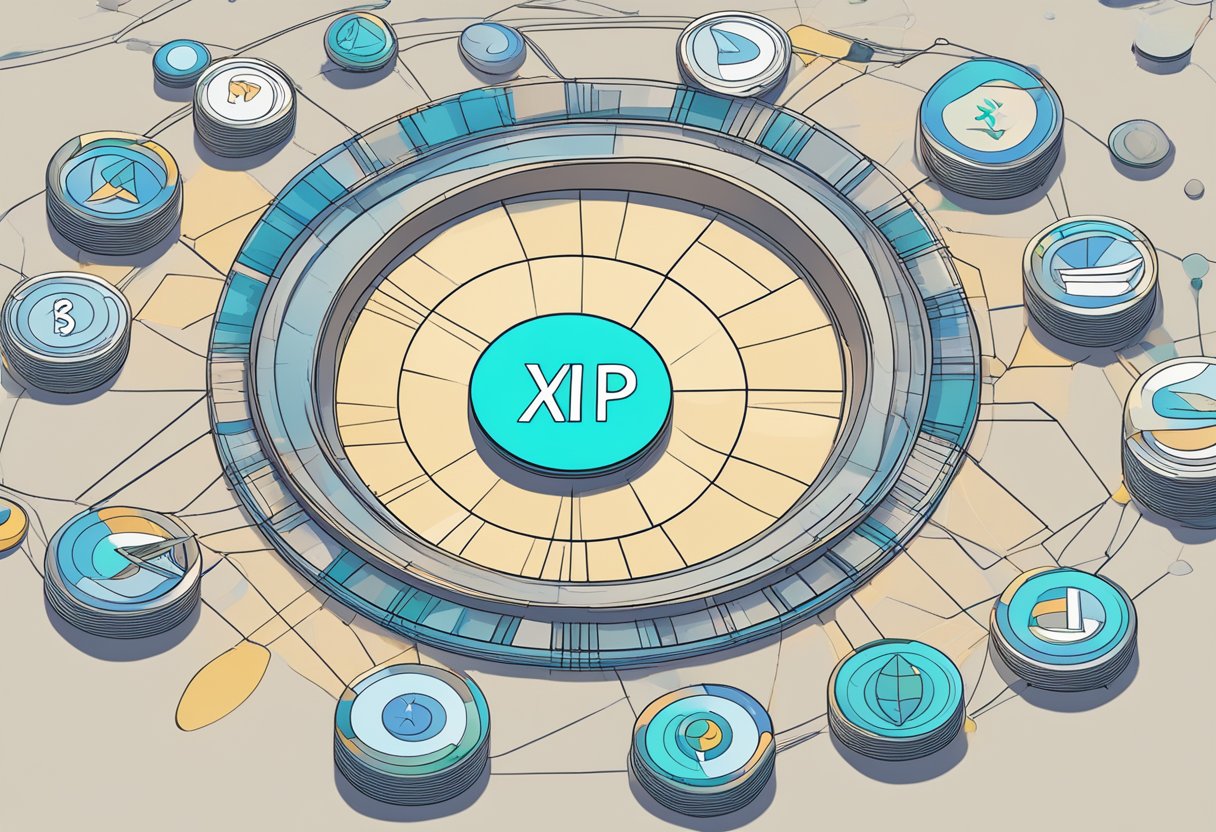Ripple (XRP), a popular cryptocurrency widely known for its focus on cross-border payments and remittance services, has been gaining significant attention among investors in recent years. With its unique consensus protocol and a fast-growing utility network, XRP has managed to sustain a top-5 ranking by market capitalization. As November approaches, many experts and analysts have begun speculating about the potential for Ripple’s market cap to reach a remarkable $50 billion milestone.

This anticipated growth in market capitalization can be attributed to a variety of factors, such as the continuous development of Ripple’s underlying technology, its expanding user base, and strategic partnerships with key players in the financial industry. Additionally, the increasing demand for cost-effective and efficient cross-border payment solutions has further cemented Ripple’s position as a leading contender in the global financial ecosystem.
While the potential for XRP’s market cap to hit $50 billion in November is not guaranteed, the current trends and industry developments certainly imply a promising future for the cryptocurrency. As the market continues to evolve, Ripple’s ability to adapt and innovate is expected to play a crucial role in maintaining its competitive edge and driving its overall value.
Ripple Vs. SEC Lawsuit

The Ripple Vs. SEC lawsuit has been a significant legal battle in the cryptocurrency sector. The Securities and Exchange Commission (SEC) initiated the lawsuit against Ripple Labs, alleging that the company’s sale of its XRP tokens constituted an unregistered securities offering.
As the case progresses, the outcome could potentially impact Ripple’s market capitalization and its growth prospects. A key aspect of the lawsuit revolves around whether the XRP token should be classified as a security or not. Ripple has consistently maintained that XRP is a digital asset and not a security, arguing that it functions as a means of cross-border transactions and has utility beyond investment purposes.
The decision in this lawsuit will have significant implications for Ripple and the cryptocurrency industry as a whole. A victory for Ripple could result in a significant boost to its market capitalization, legitimizing its operations and clearing regulatory hurdles for future developments. Conversely, if SEC emerges victorious, this could potentially lead to a decline in Ripple’s market cap, as well as increased scrutiny and regulation for the broader crypto market.
Throughout the legal battle, both Ripple and the SEC have experienced some successes and setbacks. The outcome remains uncertain, but it is clear that the final decision will have far-reaching consequences for both entities, as well as for Ripple’s potential $50B market cap in November. Ultimately, the resolution of this lawsuit will play a crucial role in shaping the future of the cryptocurrency landscape.
Understanding Ripple (XRP)

Ripple is a unique cryptocurrency that focuses primarily on facilitating fast and efficient cross-border transactions between financial institutions. Its native digital asset, known as XRP, serves as a bridge currency, enabling seamless transfers of funds between different currencies. As an altcoin with a significant market presence, XRP has secured a place among the top cryptocurrencies in terms of market capitalization, often ranking within the top five positions on CoinMarketCap.
The Ripple network, developed by Ripple Labs, uses a consensus protocol instead of the more common proof-of-work or proof-of-stake mechanisms. This approach ensures faster transaction speeds, lower transaction costs, and a reduced energy footprint, positioning XRP as an attractive solution for banks and payment processors.
XRP’s ticker symbol is “XRP,” making it easily identifiable on various cryptocurrency exchanges. Its finite supply, capped at 100 billion tokens, instills a sense of scarcity and value that appeals to investors. The circulating supply is continually adjusted through a process of periodic token releases from an escrow account, ensuring a steady and predictable flow of XRP into the market.
Investors’ interest in the potential of Ripple’s technology to revolutionize the financial industry has contributed to its rising market capitalization. With a possible $50B market cap in November, XRP stands as a strong contender in the fast-paced and ever-evolving world of cryptocurrencies.
XRP Market Cap Analysis

Ripple (XRP) has experienced significant growth over the past few years, establishing itself as a major player in the cryptocurrency market. The current market cap of XRP stands at $3.8 billion, but experts predict that it could reach a staggering $50 billion in November.
One factor contributing to this growth is the increasing adoption of Ripple’s technology by financial institutions. The company’s solutions, such as xRapid and xCurrent, are designed to facilitate faster and more cost-effective cross-border transactions. As more banks and payment providers adopt these solutions, the demand for XRP is expected to grow, potentially driving up its market cap.
Investors are also showing increased interest in XRP, as they recognize the potential for significant returns. The all-time high for Ripple’s XRP was reached in January 2018, when its market cap exceeded $130 billion. Despite market fluctuations since then, XRP has remained one of the top cryptocurrency choices for investors. As the market cap approaches $50 billion, it’s possible that we may see a new all-time high in the coming months.
Increasing revenue is another positive indicator for Ripple’s market cap growth. The company has consistently demonstrated its ability to generate revenue through its various service offerings. As more businesses turn to Ripple for innovative solutions, its revenue could continue to rise, further fueling the growth of its market cap.
In summary, several factors are contributing to the potential growth of Ripple’s XRP market cap, including increased adoption by financial institutions, rising investor interest, and consistent revenue generation. As we approach November, it will be fascinating to see if the market cap can reach the predicted $50 billion mark.
Ripple’s 2023 Performance and Future Expectations

Ripple (XRP) has shown a notable performance in 2023, with market experts expressing confidence in its potential. Throughout the year, XRP’s price has experienced fluctuations, including reaching new all time highs and lows. However, the overall trend in its price movement has been positive.
One of the factors contributing to Ripple’s success in 2023 is the increasing adoption of XRP by financial institutions and payment providers. This year, many companies have recognized the benefits of leveraging Ripple’s technology for faster, more secure, and cost-effective cross-border transactions. As a result, demand for XRP has skyrocketed, driving up its market value.
Moreover, the Ripple team has continued to make impressive strides in product development and innovation. These advancements have further solidified XRP’s position as a leading digital asset in the rapidly evolving world of cryptocurrencies. As of November 2023, XRP’s market cap is predicted to reach $50 billion, reflecting growing investor interest and market confidence.
Despite facing some challenges, such as regulatory uncertainties and market volatility, Ripple’s performance in 2023 has been commendable. As more organizations and individuals embrace XRP for its various use-cases and benefits, the future expectations for Ripple remain promising. In conclusion, Ripple’s 2023 performance is an indication of its potential to thrive in the coming years, reinforcing its position as a formidable player in the cryptocurrency arena.
XRP in the Crypto Market
Ripple’s cryptocurrency, XRP, has been making waves within the crypto market. As a top contender, it has established itself alongside giants like Bitcoin and Ethereum. In recent years, its market cap has grown steadily, and now there is a possibility for it to reach the $50B mark in November.
XRP’s rise can be attributed to several factors, including its focus on providing faster and cheaper cross-border transactions. As a result, it has caught the attention of financial institutions who have integrated it into their systems. Moreover, the crypto market’s overall bullish trend has provided a supportive ecosystem for XRP to thrive.
However, XRP faces stiff competition from several emerging cryptocurrencies. Cardano, Solana, and Polygon have been making significant strides in the market, each offering unique features and solutions. Cardano, for instance, is designed to be energy-efficient and eco-friendly. Solana boasts high transaction speeds, and Polygon focuses on facilitating seamless connectivity between Ethereum-compatible blockchain networks.
Despite the competition, XRP continues to hold a considerable share of the market. Its reputed partnerships with large financial institutions and the rapid growth of the crypto market create an optimistic outlook for its potential to achieve the $50B market cap milestone.
In conclusion, as the crypto landscape evolves, XRP’s robust technology and growing adoption set the stage for it to maintain a strong position. Encompassing a wide range of utilities and capturing significant market share, XRP has the potential to reach new heights in the coming months.
Investing in XRP
Investing in Ripple (XRP) has garnered interest among both retail and institutional investors in recent times. With expectations that the XRP market cap could reach $50B in November, many individuals and institutions are considering adding the cryptocurrency to their portfolios.
Institutional investors, such as hedge funds and large financial institutions, are increasingly recognizing the potential of Ripple and its underlying technology. As these entities enter the market, they contribute to significant buying pressure, driving up the value of XRP. This wave of institutional investment brings not only increased demand but also boosts the credibility and stability of the cryptocurrency.
Retail investors, on the other hand, can take advantage of the growing popularity of XRP by accumulating the digital asset in their portfolios. As a long-term investment strategy, dollar-cost averaging can prove beneficial, as it involves purchasing small amounts of XRP at regular intervals, regardless of price fluctuations. This method can help mitigate risk and allow investors to accumulate XRP without trying to time the market.
It’s essential for both retail and institutional investors to understand that investing in cryptocurrencies, like XRP, carries inherent risks and potential rewards. The market can be volatile and unpredictable, which is why a well-informed approach is necessary when deciding to invest. Conducting thorough research and staying informed about the latest developments in the Ripple ecosystem can help investors make informed decisions and increase the likelihood of a successful investment experience.
Key Events and Future Projections
Ripple (XRP) has experienced significant growth in recent years, with its market capitalization potentially reaching $50 billion in November. This growth can be attributed to several key events and developments in the cryptocurrency market.
The adoption of Ripple (XRP) by a growing number of banks and financial institutions has played a crucial role in its increasing market cap. In 2023, major banks such as Bank of America, and payment platforms such as MoneyGram, integrated Ripple’s payment technology into their systems, demonstrating the value of XRP and its potential to revolutionize the financial industry.
As we look ahead towards 2024 and 2025, the increased adoption of digital currencies, in general, is expected to continue driving the demand for Ripple. Furthermore, the implementation of regulatory frameworks aimed at legitimizing cryptocurrencies will positively impact the value of XRP.
In terms of future price predictions, some experts project that by 2030, Ripple (XRP) may experience substantial growth, potentially reaching new all-time highs. These predictions are founded on the increasing global demand for fast and efficient cross-border payment solutions, an area where Ripple excels.
In conclusion, the steady growth of Ripple’s market cap is a testament to its potential as a major player in the financial industry. Key events and future projections suggest that XRP will continue its upward trajectory in the coming years, driven by increasingly widespread adoption and the development of a favorable regulatory environment.
Ripple’s Role in the DeFi Space
Ripple (XRP) has been playing a significant role in the decentralized finance (DeFi) space. As one of the top cryptocurrencies, XRP aims to facilitate the integration of traditional financial systems with blockchain-based solutions to create efficient, cost-effective, and secure platforms for value transfer.
One of the primary ways Ripple is contributing to DeFi is by providing a payment protocol, the RippleNet, that allows financial institutions to process cross-border transactions seamlessly. By leveraging XRP as the native currency, the protocol enables instant settlements and lower transaction fees, which is highly desirable in the DeFi ecosystem.
Moreover, Ripple’s Interledger Protocol (ILP) connects various blockchain networks, aiding in the interoperability of different cryptocurrencies. This feature is crucial for DeFi as it allows a seamless exchange of digital assets and augments the overall growth of the decentralized finance ecosystem.
Additionally, Ripple has been actively supporting initiatives and projects in the DeFi sector. For instance, the company recently launched a $250 million fund to accelerate the growth and development of DeFi platforms and dApps on the XRP Ledger. This investment demonstrates Ripple’s commitment to fostering innovation and expansion within the DeFi space.
In summary, Ripple’s contributions to the DeFi space include facilitating cross-border payments, enhancing interoperability between blockchain networks, and direct investment in promising DeFi projects. As the appetite for decentralized finance solutions continues to grow, it is expected that Ripple (XRP) will continue to play a pivotal role in shaping the DeFi landscape.
The Effect of Market Competition
The cryptocurrency market is a highly competitive environment, where numerous digital assets vie for dominance and market share. Ripple (XRP) has managed to establish itself as a top contender in this landscape. With its unique features and focus on cross-border transactions, XRP has positioned itself to potentially reach a market capitalization of $50 billion in November.
Competition in the cryptocurrency market has increased over the years with the rise of alternative coins, or altcoins, serving various use cases and functions. As one of the leading digital assets, Ripple has been able to differentiate itself from competitors by focusing on creating solutions for international money transfers and partnering with financial institutions.
In the face of rigorous competition, Ripple has adopted strategies to stay ahead. One such approach is the continuous improvement and development of its network and technology. By doing so, Ripple ensures that its platform remains relevant and up-to-date with the evolving demands and trends in the digital asset ecosystem. This fosters investor confidence and contributes to the growth of XRP’s market capitalization.
Another factor that influences the effect of market competition on Ripple’s market cap is the performance of other cryptocurrencies. Fluctuations in the value of leading digital assets, such as Bitcoin and Ethereum, can impact the investment landscape, driving attention and capital towards or away from XRP. Ripple may also interact with emerging digital assets that target similar use cases or that could potentially challenge its position in the market. The more competition XRP encounters, the higher the pressure to innovate and maintain its standing.
In summary, market competition plays a significant role in shaping the trajectory of Ripple’s market cap. By recognizing and responding to the challenges posed by competing cryptocurrencies and altcoins, Ripple can adapt and maintain its position in the industry. Staying ahead of these trends while fostering innovation and development in its technology will be crucial for Ripple to reach a market capitalization of $50 billion and continue as a leading digital asset.
Impact of XRP Trading Volume
Ripple (XRP) has been gaining attention in the cryptocurrency market due to its increasing trading volume. As a top-5 crypto asset by market capitalization, XRP’s rising trading volume has been instrumental in driving its market cap closer to the $50 billion mark.
The trading volume of a cryptocurrency like XRP is an essential factor to consider when trying to predict its market cap. It represents the total amount of the crypto asset being traded within a specific period. Higher trading volume usually indicates growing interest from investors, which can lead to an increase in price and market capitalization.
In the case of XRP, increased trading volume has the potential to positively impact its market cap. This is because a higher volume could signify that more people are buying and selling the crypto asset, indicating a growing demand for XRP in the market. As a result, the price of XRP is likely to rise, leading to an increase in its market cap.
It is also important to note that the crypto hourly trading volume can provide insights into the short-term fluctuations of XRP’s price. By monitoring the hourly trading volume, investors can make well-informed decisions on when to enter or exit the market.
In conclusion, the growing trading volume of Ripple (XRP) can significantly impact its market cap. As the crypto asset continues to gain popularity and attract more investors, its trading volume is likely to keep rising, which could eventually push its market cap to the $50 billion mark by November.
Ripple’s Adoption by Banks and Financial Institutions
Ripple (XRP) has been making waves in the financial world, as banks and financial institutions begin to recognize its potential for streamlining cross-border transactions and reducing operational costs. The growing adoption of Ripple by these institutions could play a significant role in boosting its market cap, potentially driving it towards the $50B mark in November.
One notable example of Ripple’s expanding influence is its partnership with Santander, a major global bank. Santander has been using Ripple’s technology to develop a new international payments app, providing faster and more efficient transactions for its customers. This collaboration highlights how financial institutions are increasingly viewing Ripple as a viable alternative to traditional payment methods like SWIFT, which can be costly and time-consuming.
Additionally, Ripple has been making strides in securing partnerships with other prominent banks and financial organizations. These partnerships not only serve to enhance Ripple’s credibility within the financial sector but also contribute to increased demand for XRP, the digital asset underlying the Ripple network.
As more and more institutions adopt Ripple’s technology, the progressive expansion of its network effect is anticipated. This is crucial in terms of driving XRP’s value and market capitalization. By offering superior speed, transparency, and cost-efficiency, Ripple has the potential to significantly disrupt the traditional financial industry, making it an attractive proposition for banks and other financial entities.
In summary, Ripple’s growing adoption by banks and financial institutions is an essential factor in its potential market cap growth. As more establishments recognize the benefits offered by Ripple’s technology and opt to incorporate it into their systems, the market cap could well reach the $50B milestone in November. The partnerships with major players like Santander, coupled with its increasing network effect, support this projection and emphasize Ripple’s emerging presence in the world of digital finance.
Reflection on Community Support for XRP
The XRP community has shown a remarkable level of support and enthusiasm for the Ripple cryptocurrency. They understand the potential benefits and value XRP has to offer in the financial world. The community’s confidence in XRP’s potential is evident in the market capitalization, which has been speculated to reach $50B by November.
As a diverse group of individuals, the XRP community consists of investors, enthusiasts, developers, and businesses all working together to promote and support the growth and adoption of Ripple. They actively participate in discussions, share ideas, and collaborate on projects that can help enhance XRP’s functionality and broader use cases.
Some reasons behind this strong support level from the community include the belief in the transformative potential of XRP in disrupting the traditional financial system. Ripple’s innovative technology enables faster and cheaper cross-border transactions compared to traditional methods. Due to its efficiency and scalability, XRP has attracted interest from major banks and financial institutions, further boosting the community’s trust in its long-term prospects.
Furthermore, the XRP community remains active on various social media platforms, such as Twitter, Reddit, and Telegram, where they share news, opinions, and insights about Ripple. This constant flow of information and discussions helps reinforce confidence in XRP and keeps the community engaged and motivated.
In conclusion, the XRP community’s support has played a significant role in Ripple’s growth, and their confidence in the cryptocurrency’s potential continues to drive its market cap higher. Their collective efforts in promoting and supporting the development of XRP signify their belief in its ability to revolutionize the financial industry and become a dominant player in the cryptocurrency market.
Conclusion: Ripple’s Potential to Reach $50B Market Cap
In the world of cryptocurrencies, market capitalization is an important indicator of the value and stability of a digital currency. For Ripple (XRP), reaching a $50B market cap could be a significant milestone that showcases the growing adoption of this cryptocurrency.
Ripple, the company behind the XRP token, has been making strides in establishing their payment platform within the financial industry. By partnering with various banks, financial institutions, and remittance companies, Ripple aims to streamline and reduce the cost of cross-border transactions. As more businesses adopt Ripple’s payment platform, the value of XRP is expected to grow.
The increasing interest in digital currencies from institutional investors also plays a crucial role in driving the market cap of cryptocurrencies, including Ripple (XRP). As regulatory frameworks around cryptocurrencies mature and gain clarity, institutional investors may feel more confident in adding digital assets like XRP to their portfolios, ultimately increasing its market capitalization.
Although Ripple faces competition from other cryptocurrencies and traditional payment platforms, its focus on enabling near-instant, low-cost international transactions sets it apart. This unique value proposition could potentially attract more users and investors to the XRP ecosystem, propelling the market cap closer to the $50B mark.
In conclusion, the potential for Ripple’s XRP to reach a $50B market cap depends on several factors, including increased adoption by businesses, interest from institutional investors, and its competitive advantages over other digital currencies. While there are no guarantees in the ever-evolving world of cryptocurrencies, Ripple’s continued progress and growth suggests that a $50B market cap is certainly within the realm of possibility.
